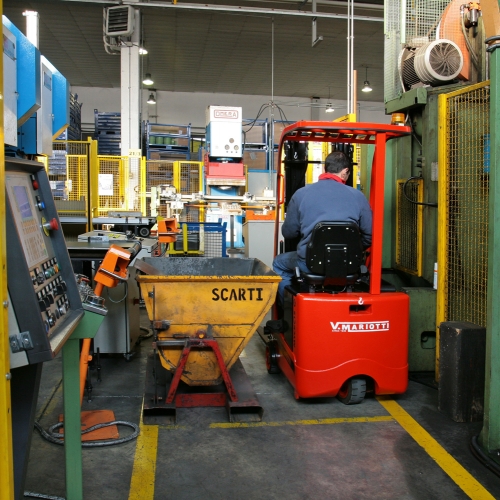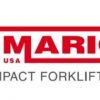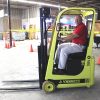Quick Tips To Be OSHA Compliant When Using A Forklift
Whether you’re brand new to the material handling industry or you’ve been around forklifts and large material handling equipment for decades, safety reminders are always beneficial. It just takes one person making one unsafe decision in one moment to cause a big, irreversible problem.
OSHA standards require many different safety features and behaviors in order to keep forklift operators safe in the moment. The most important thing about forklift operation is that the drivers and pedestrians go home safe at the end of the day.
Safety is a topic that cannot be taken lightly. Refresh your staff with frequent trainings and reminders to keep these ideas in mind each and every day they are operating or working near a forklift. You should review the entire OSHA standards regularly, but this list is a quick reminder that will go a long way in between full safety reviews.
Eight Safety Tips to Exercise On or Near a Forklift
#1 Age and Certification
All forklift operators are required to be over the age of 18 and to have completed the operation skill training course. This training must be renewed every three years and is offered at a variety of our locations.
#2 Visual Inspection
Always complete a visual inspection before using a forklift. Most forklift operators are not technicians, so it’s important that you’re only doing a visual inspection. Look for leaks, objects in the way of the unit, or issues with the tires or forks. If you see a leak, do not touch it. Don’t place your hand under or into anything in order to feel for cracks or leaks. This is a visual inspection only, because the leak could contain hazardous chemicals that could cause serious injury. Leave the leaks to the professionals. If you see a leak be sure to report it to your supervisor and in the meantime, use a different piece of equipment.
#3 Seat Belt
Every time you’re operating a forklift you should be wearing your seatbelt. Many makes and models now have a bright red seat belt which makes it obvious to pedestrians and supervisors whether or not you have the belt in place. Do your part to also remind your coworkers this is a necessity. It just takes a moment to buckle it in place, so be safe in the moment.
#4 Speed
Obey the speed limit in your warehouse. Remember that forklift speed isn’t only about the operator being able to safely maneuver the machine, but also about the safety of the pedestrians walking near the unit. Driving at a responsible speed ensures the driver stays alert and is able to react in plenty of time, while also giving pedestrians ample time to see equipment approaching.
#5 Use a Spotter
To increase safety and decrease damage in small areas, enlist the help of a spotter. Driving a forklift with obstructed views due to shelves, racks and even the mast arms on the lift itself can increase the chances of injury, damage to the forklift, or damage to the load or storage system. By working with a spotter who can give hand signals and verbal cues, you will drastically increase the safety in those tight, hard-to-see spaces.
#6 Three Touch Points
When you’re entering and exiting the forklift at the beginning or the end of use, always use the 3 Touch Point system. A hand and two feet, or two hands and a foot should always be touching the unit as you climb up or down. Never jump from the unit or step into it without some extra support from the handles. Those handles are there for a reason, so use them!
#7 Sound the Horn
Use the horn around corners or in low visibility areas. Never assume others will see you coming. The honking of your horn is a simple safety procedure that should be in place in every material handling business. It’s a little habit that goes a long way when it comes to safety. People get distracted, or they may not be looking in your direction, so give them every opportunity to know you’re operating a large piece of equipment and you’re headed their way.
#8 Turning
Slow down when turning. As we pointed out in tip #4, speed can impact both the driver’s ability to operate the forklift safely and the pedestrians ability to stay clear of the unit, but speed around corners should also be addressed. Always be mindful that turning can make it hard for others to see you coming. Not only that, but corners increase the need to be aware of the load you are carrying. Turning too quickly can cause a load and thereby the forklift itself to become unbalanced, so be sure to slow down as you approach each and every turn. Safety in every moment is the only way.
#9 Lower the Forks
Drive the forklift with the forks lowered to about 4-6 inches off the ground. You never want to drag the forks along the ground, nor do you want to drive with them too high. Operating a forklift with the forks positioned too high could cause them to make contact with a person or object. Those large metal forks don’t have much give, so keep them near the ground where they won’t hurt anything or anyone.
4 Unsafe Forklift Practices to Avoid
Now that we’ve covered some of the more important safety habits we should develop as responsible forklift operators and employee supervisors, we’ll cover a few things NOT to do. Most of them are pretty straight forward, but you never know who might need to be reminded of these things. A brief safety reminder meeting today could prevent a serious accident. Take a minute to remind your staff NOT to do these things.
#1 DON’T drive over objects
A piece of wood on the floor, a large rock on the ground, a small metal object--many of these things seem innocent enough for your tough and rugged unit to drive right over, but it’s never a good habit to start. Always encourage your staff to move objects or drive around them instead of driving over them. Not only will it increase their safety and the safety of those near them, but it will increase the life and usability of your forklift tires and the unit in general.
#2 DON’T carry unstable loads
Pallets or loads not centered on your forks could cause sliding or tipping that could injure yourself, others, or the load you’re carrying. Always take the extra time to reposition a load whose center of gravity isn’t stable. It may take a few extra minutes to get it positioned properly, but it will be time well spent.
#3 DON’T allow riders
All certified forklift drivers know this is not a safe practice, but make sure you’re holding the rest of your coworkers accountable to the same standard. It’s never okay to allow someone to jump on the back of your forklift or to ride on the forks, for any reason. Never compromise on this safety expectation.
#4 DON’T Carry loads that are too heavy or too tall
Be mindful of the height of the doorways you’re driving through or other objects that may come in contact with the load you are hauling. It just takes one moment of forgetting this point to cause serious damage. Also, knowing the maximum capacity of your unit in relation to how heavy of a load you are moving is important. If you’re close or over the limit, reduce the size of your load and make multiple trips or find a unit that is better equipped to handle a load of that weight.

Related Articles
-

MARIOTTI USA, INC. ANNOUNCES PETER HINRICHS PROMOTION TO DIRECTOR OF SALES OF NORTH AMERICAN REGION
Mariotti USA announced the promotion of Peter Hinrichs, from Business Development Manager of North American Sales to Director of Sales for Mariotti USA. As Mariotti Forklifts enters its 20th year as the exclusive distributor for Mariotti USA and 25th year distributing forklift products in North America, its success has been…
Learn More -

Mariotti USA Adds Denver-Based Dealer to Exclusive Network
Mariotti USA, the North American distributor of V.Mariotti lift trucks, added Welch Equipment Company to its exclusive network of licensed dealers
Learn More -

Pete Hinrichs Celebrates 5 Years at Mariotti USA
Mariotti USA is confident that he will keep up the good work for many years to come!
Learn More
